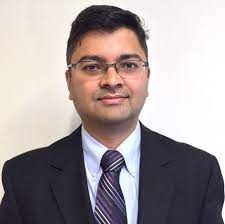TEMPLE, TX — Part of the inspiration for Chetan Jinadatha, MD, MPH, to specialize in treating infectious disease comes from going to medical school in his native India, which has a high burden of such diseases. However, he also likes to say it’s partly for selfish reasons.
“What gets me really excited about infectious disease is the fact that I can cure people,” Jinadatha explained. “An infectious disease can be something that is very interesting and difficult to figure out, but—once you figure it out, and you get them the right treatment—patients walk out of the hospital, and hopefully you never see them again. It’s selfish, because it’s instant gratification. And because you feel good about making a difference in people’s lives.”
The reward that comes from his other passion—inventing new ways to prevent diseases from spreading in the first place—is not so instant. In fact, the one idea that he has had to go the distance, from conception to widespread manufacture, was a 12-year journey that started when he saw a nurse loading IV poles into an elevator.
“I would see nurses get on and off the elevator taking medical equipment to be sterilized—while also bringing more up,” he explained. “They’d have a bunch in one hand and a bunch in the other, and which were clean and which were dirty? How could they tell?”
This was at the Olin E. Teague VAMC in Temple, TX, where Jinadatha has worked since 2010 and now serves as chief of infectious diseases.
He knew the equipment, after being used, was taken down to the sterile processing department, where it was cleaned and logged onto a clipboard. There was no tag, no sticker that said “disinfected six hours ago”—no way to tell at a glance which piece of mobile medical equipment had been cleaned or when.
“My goal in life is to prevent every single hospital acquired infection,” Jinadatha declared. “It’s not one problem and I solve it and it goes away. It involves the hands of healthcare workers, contaminated surfaces and organisms that can pass from patient to patient through equipment. I’m always striving to understand and prevent this transmission cycle.”
The goal of cleaning equipment is to clean it after each use, although that might not always happen.
“Sometimes people forget,” Jinadatha admitted. “Life gets busy, and things don’t happen.”
His solution was a disinfection tracking system (DTS), consisting of a small device attached to the portable medical equipment that detects the liquid chemicals used to disinfect the equipment and which has a screen displaying how long ago the device was cleaned. The system connects to an online platform that logs each piece of monitored equipment.
The hospital began using Jinadatha’s invention on computers on wheels (COWs) and then later expanded the system to include other equipment.
Because he invented the idea as part of his role at VA, the department owns the idea, but Jinadatha has remained a part of the process throughout.
“VA is a very good place for inventors because the VA is a very fair system for people like us,” Jinadatha said. “Once you conceive an idea and you think it’s good enough that you think it could be a patent, you put a rough draft of it and disclose it to VA’s Technology Transfer Office. They evaluate the disclosure and decide if it’s unique enough for VA to protect it with IP.”
That’s what happened in the case of the DTS. Once VA patented the idea, they began marketing it to manufacturers. The idea was eventually licensed by Xenex Disinfection Services, which announced its release earlier this summer under the name TrackMate—12 years after Jinadatha originally came up with the idea.
Now, the doctor-turned-inventor has already moved on to new ideas. For the past several years, he’s been working with a colleague on the use of ferrate compositions for surface disinfection.
“We think the molecule has potential … as a point-of-surface disinfectant,” he explained. “We could use it in war-torn areas and by soldiers in the field.”
As for why physicians should also take on the role of inventors and innovators, Jinadatha explained that it was a matter of scale.
“I teach residents and fellows, and I’ll tell them that, as a doctor, you can make a difference for one patient at a time,” he said. “If you’re a great researcher, you can make a difference for hundreds at a time by teaching others how to do a better job. And if you’re an innovator, and you invent something, then you do something you can affect hundreds of thousands of people.”
When asked if it was difficult to be patient when the journey from idea to conception can be so long, Jinadatha said he focuses on the reward.
“Before COVID, nothing happened in a hurry,” he said. “Afterward, definitely nothing happened in a hurry. You have to be patient, you have to grind, you have to improve, and you have to learn. And hopefully, at the end of the day, there’s a fruitful reward. And do not be afraid of failure. Failure is the next step to more success.”


